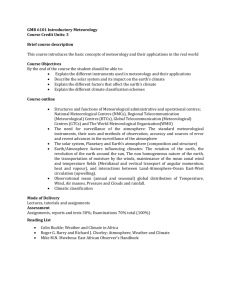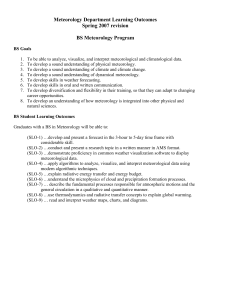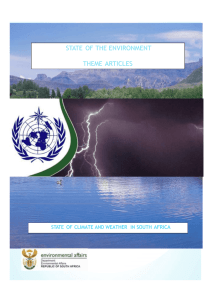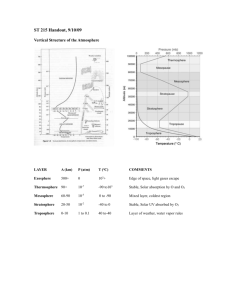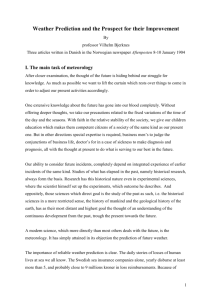Harold Washington College Introduction to Meteorology Master
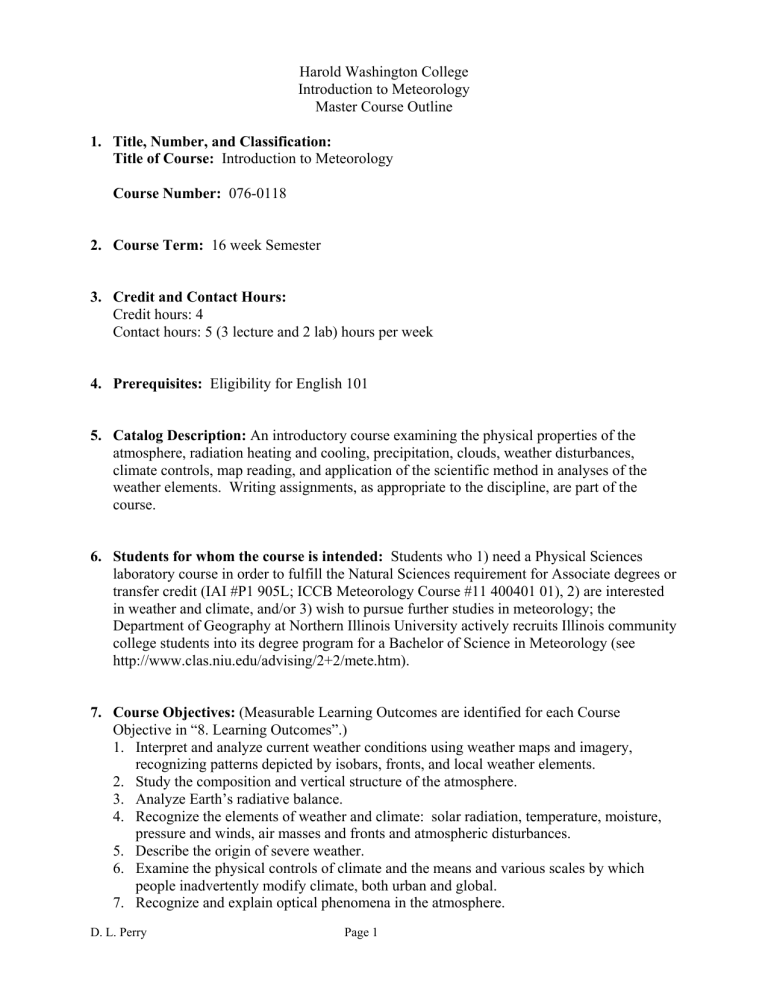
1. Title, Number, and Classification:
Title of Course: Introduction to Meteorology
Course Number: 076-0118
Harold Washington College
Introduction to Meteorology
Master Course Outline
2. Course 16 week Semester
3. Credit and Contact Hours:
Credit hours: 4
Contact hours: 5 (3 lecture and 2 lab) hours per week
4. Prerequisites: Eligibility for English 101
5. Catalog Description: An introductory course examining the physical properties of the atmosphere, radiation heating and cooling, precipitation, clouds, weather disturbances, climate controls, map reading, and application of the scientific method in analyses of the weather elements. Writing assignments, as appropriate to the discipline, are part of the course.
6. Students for whom the course is intended: Students who 1) need a Physical Sciences laboratory course in order to fulfill the Natural Sciences requirement for Associate degrees or transfer credit (IAI #P1 905L; ICCB Meteorology Course #11 400401 01), 2) are interested in weather and climate, and/or 3) wish to pursue further studies in meteorology; the
Department of Geography at Northern Illinois University actively recruits Illinois community college students into its degree program for a Bachelor of Science in Meteorology (see http://www.clas.niu.edu/advising/2+2/mete.htm).
Objective in “8. Learning Outcomes”.)
1. Interpret and analyze current weather conditions using weather maps and imagery, recognizing patterns depicted by isobars, fronts, and local weather elements.
2. Study the composition and vertical structure of the atmosphere.
3. Analyze Earth’s radiative balance.
4. Recognize the elements of weather and climate: solar radiation, temperature, moisture, pressure and winds, air masses and fronts and atmospheric disturbances.
5. Describe the origin of severe weather.
6. Examine the physical controls of climate and the means and various scales by which people inadvertently modify climate, both urban and global.
7. Recognize and explain optical phenomena in the atmosphere.
D. L. Perry Page 1
8. Learning (The numbered Learning Outcomes correlate to the numbers in “7.
Course Objectives”.)
Upon completion of this course, the student will have demonstrated the ability to:
1. a. Interpret and utilize satellite imagery. b. Analyze surface weather maps and upper air charts. c. Recognize fronts from patterns depicted by isobars on surface weather maps. d. Discuss the intricacies and limitations of weather forecasting.
2. a. Describe the composition of the atmosphere and how it evolved over time. b. Identify the components and properties of the four major layers of Earth’s atmosphere.
3. a. Integrate the relationship between solar radiation and Earth in generating weather. b. Explain the cause and mechanism of the natural greenhouse effect. c. Describe the relationships between the sun and the earth that cause the seasons.
4. a. Differentiate among conduction, convection, and radiation. b. Describe the role of moisture in the atmosphere, including concepts such as evaporation, condensation, cloud formation, and precipitation. c. Identify different cloud types and explain their occurrences. d. Recognize the different types of fog and precipitation and explain why each occurs. e. Analyze the concept of atmospheric pressure and its effects on weather and winds. f. Illustrate the Coriolis Effect and its implications for wind patterns. g. Identify and name the four major air masses and the concept of their source regions. h. Identify and name the four major types of fronts, and the weather that they generate. i. Discuss mid-latitude cyclones and anticyclones and their effect on U.S. weather.
5. a. Describe the life cycle of a thunderstorm. b. Explain why lightning occurs. c. Describe the origin and development of severe weather such as hurricanes and tornadoes.
6. a. Recognize global weather patterns and climatic zones and explain their distribution. b. Relate the mechanisms of both the anthropogenic greenhouse effect and ozone layer depletion to how human activity impacts the atmosphere.
7. a. Explain why the sky is blue. b. Describe why rainbows and other optical phenomena form.
9. Topical Course Outline:
See next page for Topical Course Outline
D. L. Perry Page 2
9. Topical Course Outline:
Week Topics
2 Weather info and maps
3 Atmosphere
4 Radiation
5 Atmospheric circulation
6
7
Air pressure
Humidity
Chapter
Reference Labs
1
1 1. Pressure
2
3
2.
3. map
4
5
4. Temp/wind chill
5. Pressure change
6 6. Clouds; T, P changes
10
11
Wind
Planetary circulations
7 7. Precipitation/Doppler
8 8. Sfc/upper forces
9
10
11
12
9. Jet stream/El Nino
10. Midlat cyclone
11. T-storms/tornadoes
12. Hurricanes
13 Thunderstorms, tornadoes
14 Tropical storms
15 Review and/or extra material 13. Possible extra lab
10. Texts and Materials:
Moran, J. 2002. Online Weather Studies (Second Edition), American Meteorological Society:
Boston, MA.
American Meteorological Society. 2004. Online Weather Studies – Investigations Manual
(Eighth Printing): Boston, MA. (This is used as the lab manual.)
11. Methods of Instruction:
Instruction methods may include class lecture/discussions that explore a broad range of topics in meteorology (see “9. Topical Course Outline”), daily weather briefings using realtime online weather information, and laboratory exercises worked in groups. The course content may follow the American Meteorological Society's Online Weather Studies * text and laboratory manual.
Laboratory exercises will apply those concepts learned from the course material to weather analysis through written and online atmospheric investigations. The written exercises are provided in the Online Weather Studies – Investigations Manual, and the online investigations are updated twice weekly with real-time weather data on the American Meteorological Society
Online Weather Studies course homepage (www.ametsoc.org/amsedu/online/onlinewx).
Students will be provided the password from the American Meteorological Society to access the online portion of the labs.
D. L. Perry Page 3
*Note: Harold Washington College (HWC) is participating in the Online Weather Studies
Geosciences Diversity/National Dissemination Project, a program sponsored by the
National Science Foundation and the National Weather Service that provides geoscience courses, such as Online Weather Studies , to students in minority-serving institutions. As a participant, HWC can license the course for student access during the semester the
Meteorology course is offered for a current fee of $49 per semester or $79 per year, if the course is offered more than one semester per year. Additionally, the American
Meteorological Society publishes updated course textbooks and materials for students to purchase at Beck’s Bookstore. For more information regarding the Online Weather
Studies Geosciences Diversity/National Dissemination Project, please see the Online
Weather Studies course homepage at www.ametsoc.org/amsedu/online/onlinewx.
12. Methods of Evaluation:
Student understanding of the course objectives may be evaluated through such methods as: a weather journal, weather briefings, writing assignments, laboratory investigations, unit exams, and a final exam.
Authorized Signature and File
Date: ___________________
D. L. Perry Page 4

